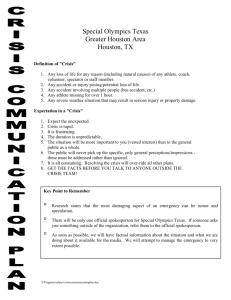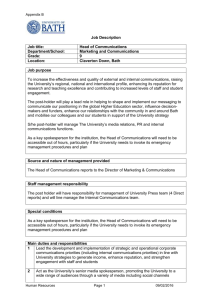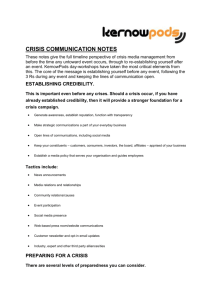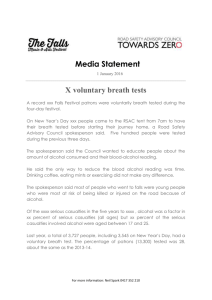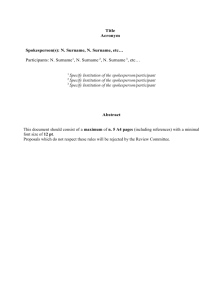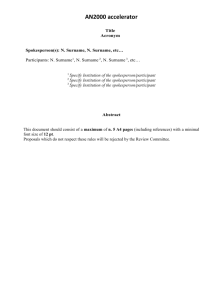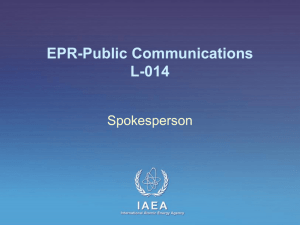Bed Bug Media Communication Plan
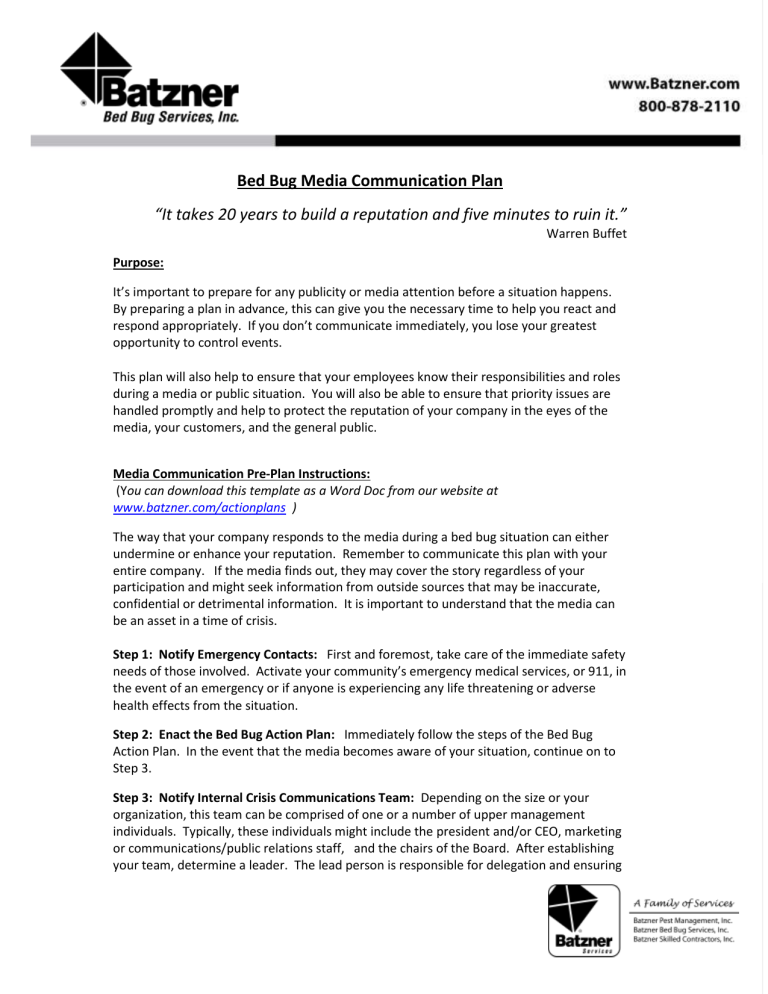
Bed Bug Media Communication Plan
“It takes 20 years to build a reputation and five minutes to ruin it.”
Warren Buffet
Purpose:
It’s important to prepare for any publicity or media attention before a situation happens.
By preparing a plan in advance, this can give you the necessary time to help you react and respond appropriately. If you don’t communicate immediately, you lose your greatest opportunity to control events.
This plan will also help to ensure that your employees know their responsibilities and roles during a media or public situation. You will also be able to ensure that priority issues are handled promptly and help to protect the reputation of your company in the eyes of the media, your customers, and the general public.
Media Communication Pre-Plan Instructions:
(You can download this template as a Word Doc from our website at www.batzner.com/actionplans )
The way that your company responds to the media during a bed bug situation can either undermine or enhance your reputation. Remember to communicate this plan with your entire company. If the media finds out, they may cover the story regardless of your participation and might seek information from outside sources that may be inaccurate, confidential or detrimental information. It is important to understand that the media can be an asset in a time of crisis.
Step 1: Notify Emergency Contacts: First and foremost, take care of the immediate safety needs of those involved. Activate your community’s emergency medical services, or 911, in the event of an emergency or if anyone is experiencing any life threatening or adverse health effects from the situation.
Step 2: Enact the Bed Bug Action Plan: Immediately follow the steps of the Bed Bug
Action Plan. In the event that the media becomes aware of your situation, continue on to
Step 3.
Step 3: Notify Internal Crisis Communications Team: Depending on the size or your organization, this team can be comprised of one or a number of upper management individuals. Typically, these individuals might include the president and/or CEO, marketing or communications/public relations staff, and the chairs of the Board. After establishing your team, determine a leader. The lead person is responsible for delegation and ensuring
all tasks are completed (see Appendix A at the end of this document). It is this team’s overall responsibility to review the situation and manage the communication surrounding the issue. The task list should include:
Determine the spokesperson who will answer all media and other inquiries. This individual could be anyone on the Communication Team or someone who is a trained public speaker and is comfortable in front of a camera.
Assess the situation to determine the facts. Information shall not be released until the Crisis Communications Team convenes, reviews the situation, and develops a strategy.
Prepare an official response for the media and public. This statement needs to be an overview of the situation and include key facts. It should acknowledge the situation and what steps will be taken to rectify it and (if possible) prevent it from occurring again. Keep the statement clear, honest and transparent. It should attempt to reinforce the positive and be action/solution oriented if possible.
Prepare key messages for the spokesperson. The spokesperson should spend some time rehearsing the prepared statements. He/she should also practice answering possible "tough" questions that may be asked by reporters. Be prepared to answer any question that may be asked. It is better to over-prepare than to be surprised by the depth of questioning by the media. Don’t volunteer information, unless it is a point that the company wants to make. And, don’t talk off the record. If you are asked a question that you do not know the answer to, do not speculate. Respond that you do not have that information and will be happy to find out and get back to the inquirer.
Recognize that unfavorable, inaccurate information, if not corrected, could have future negative consequences requiring additional responses.
Gain management input and buy-in (legal and corporate approval).
Determine if a press release is necessary.
If a large amount of media attention is given to a bed bug situation, it may be advisable that your company post a statement to your company web site, blog, and any other social media outlets that you utilize. In addition, you may want to offer resources for dealing with the situation, when applicable, and updates as they develop.
Remember, social media can be an extremely useful tool during crisis situations.
The format and nature of social media encourage users to share information with others, helping to spread your message more quickly than many other forms of communication.
Crisis Communication Team Leader (CCTL):
Name: ______________________________________Phone #: _____________________
Crisis Communication Team Members:
Name: ______________________________________Phone #: _____________________
Name: ______________________________________Phone #: _____________________
Name: ______________________________________Phone #: _____________________
Name: ______________________________________Phone #: _____________________
Name: ______________________________________Phone #: _____________________
Spokesperson(s):
Name: ______________________________________Phone #: _____________________
Name: ______________________________________Phone #: _____________________
Name: ______________________________________Phone #: _____________________
Step 4: Notify Employees of Situation: Create plan of action for internal communications.
Develop factual, detailed messages that reflect the status of the situation, and, proactive steps to resolve the situation.
Prepare talking points and provide a script for the call center or person(s) receiving incoming calls.
Person(s) responsible for notifying employees of situation and for distributing talking points and scripts to the phone center or person(s) receiving incoming calls:
Name: ______________________________________Phone #: _____________________
Name: ______________________________________Phone #: _____________________
Name: ______________________________________Phone #: _____________________
Step 5: Manage Media/Press Inquiries: All media contacts should be double checked to be sure all inquires/interactions have been completed. Also, add new names to the organization’s media list.
Media access to organization’s facilities should be supervised. Know ahead of time who the journalist is and what he or she is planning on covering.
Be sure the area into which the media are invited does not have sensitive information such as reports, personnel information or other papers visually available.
Phone center or person(s) receiving incoming calls and all employees should direct all calls, inquires, and media requests to the Media Contact Person:
Name: ______________________________________Phone #: _____________________
**(Be sure to inform all employees that information shall not be released by anyone other than the Spokesperson(s). The Media Contact person assists the Spokesperson(s) to coordinate any media requests . The Media Contact person also keeps a log of all media
requests and ensures that all are fulfilled.)
Step 6: Record Keeping: Document critical conversations, decisions, details, and media questions regarding the situation in order to effectively evaluate message effectiveness.
Step 7: Evaluate crisis communications efforts: Evaluate appropriateness and traction of messages throughout the situation.
Re-convene Crisis Communications Team to evaluate response, actions, what didn’t work, what needs to be improved/revised for the future, etc.
Review media coverage. Check for message consistency. Are there issues that might need further clarification or follow-up.
File notes, clips, talking points, communication, etc. into a folder. Revise the media communication plan if necessary.
APPENDIX A
Crisis Communication Team Leader (CCTL)Checklist
After your Media Communication Plan has been developed, list the “action items” (items from the plan that require a person to act) in a simple chart, and identify who is responsible for each item on the list. This ensures that everyone knows who is responsible for each item and that nothing is forgotten in the commotion of a crisis situation. The lead person is responsible for delegation and ensuring all tasks are completed.
Media Communication
Responsibilities
Person(s) Responsible Date/Time & Initials when
Completed
Notify 911 or EMS (if needed)
Notify Communication Team
Notify Spokesperson(s)
Assess the situation, collect data/facts
Prepare official response
Develop Key Messages/Talking Points
& Scripts
Obtain Management/Corporate and
Legal Approval
Prepare Press Release (if needed)
Prepare Social Media response (if needed)
Notify Employees – get script and talking points to call center
Determine Internal Media Contact
Person - Manage media and coordinate with designated spokesperson(s)
Determine Record Keeper – document event and submit report to CCTL
Set up Crisis Communication Team
Post-Evaluation Meeting
![Crisis Communication[1] - NorthSky Nonprofit Network](http://s2.studylib.net/store/data/005428035_1-f9c5506cadfb4c60d93c8edcbd9d55bf-300x300.png)

